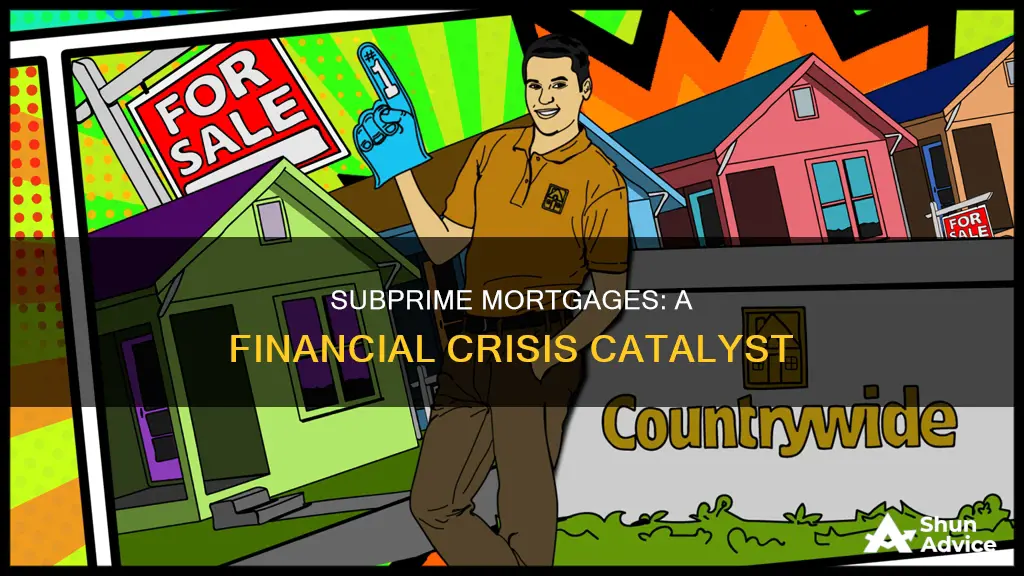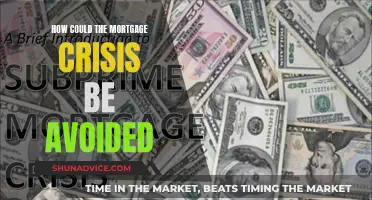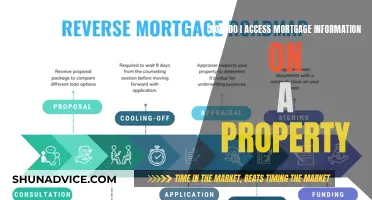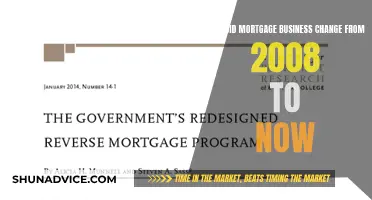
The subprime mortgage crisis of 2007–2010 was a significant event that had a profound impact on financial markets and the global economy. It was characterised by the unregulated creation and trade of derivatives, excessive leverage, and misplaced confidence in the housing market, leading to a fragile financial structure. The crisis resulted from a combination of factors, including the expansion of mortgages to high-risk borrowers, rising house prices, and complex financial products. As the crisis unfolded, it triggered a downward spiral in house prices, contributing to a period of turmoil in financial markets and leading to the Great Recession of 2008.
| Characteristics | Values |
|---|---|
| Date | 2007-2011 |
| Causes | Unregulated creation and trade of derivatives, excessive leverage, misplaced confidence in the housing market, loose lending standards, risky mortgages, expansion of mortgages to high-risk borrowers, rising house prices, excessive consumer housing debt, weak underwriting standards, unsound risk management practices, complex and opaque financial products |
| Impact | Financial losses, collapse of financial structure, decline in overall economic activity, increased unemployment, downward spiral in house prices, reduced construction, reduced consumer spending, decreased ability of financial firms to lend and raise funds, massive market sell-offs |
What You'll Learn

The role of mortgage brokers and investment firms
The subprime mortgage crisis of 2007–2010 was caused by a combination of factors, including the unregulated creation and trade of derivatives, excessive leverage, and misplaced confidence in the housing market. Mortgage brokers and investment firms played a significant role in the crisis.
The Role of Mortgage Brokers
Before the subprime crisis, mortgage brokers originated about 65% of all subprime mortgages. Brokers earned high profits on loans that turned out to be riskier than expected. They profited from the home loan boom but did not adequately assess borrowers' ability to repay their loans. This resulted in mortgage fraud and an increase in predatory lending practices, such as adjustable-rate mortgages and indirect sales via mortgage brokers. The use of automated loan approvals further contributed to the issue, with 40% of all subprime loans in 2007 resulting from automated underwriting.
The Role of Investment Firms
Investment banks issued mortgage-backed securities (MBS) at unprecedented levels during the housing boom. MBSes, tied to the real estate sector, became highly attractive financial assets, with both individual investors and financial institutions ignoring the associated risks. As a result, their value rose steadily, creating a false perception of security and profitability. However, when the housing market faltered, the value of MBSes plummeted, leading to significant financial losses.
Additionally, credit rating agencies, including "Big Three" agencies like Moody's Investors Service and Standard & Poor's, gave investment-grade ratings to MBSes based on risky subprime mortgage loans. This further misled investors about the risks associated with these financial products. The incentive compensation structure for traders also contributed to the issue, as it focused on fees generated from assembling financial products rather than the long-term performance and profits of those products.
The combination of these factors created a fragile financial structure that ultimately collapsed, impacting the global economy.
Carrington Mortgage Email Formatting: A Comprehensive Guide
You may want to see also

The impact on investment banks
The impact of the subprime mortgage crisis on investment banks was significant. The crisis, which lasted from 2007 to 2010, was characterised by a sharp increase in high-risk mortgage defaults, resulting from the housing boom and the subsequent bust. This had a direct effect on investment banks, as they had issued mortgage-backed securities (MBS) at unprecedented levels during the housing boom. When homeowners began to default on their mortgages en masse, the value of MBS plummeted, leading to substantial financial losses for the banks.
The crisis was precipitated by a combination of factors, including loose lending standards, risky mortgages, and the creation of complex and opaque financial products. Investment banks played a pivotal role in the proliferation of MBS, which were tied to the real estate sector. These securities became highly attractive financial assets during the housing boom, with both individual investors and financial institutions overlooking the associated risks. The perception of security and profitability was short-lived, however, as the faltering housing market caused the value of MBS to tumble.
The precarious financial position of major investment banks was further exacerbated by the globalised nature of the modern economy. As major economies like the US experienced downturns, the impact reverberated worldwide. The interdependence of financial markets meant that the initial shockwaves from the subprime mortgage crisis quickly led to a broader financial crisis, the Great Recession, and massive market sell-offs.
The consequences of the crisis on investment banks were profound and far-reaching. The decline in overall economic activity, coupled with the steep rise in unemployment, contributed to a downward spiral in the financial sector. Banks suffered from widespread losses, and their ability to lend and raise funds was significantly diminished. The crisis exposed the vulnerabilities of a financial system heavily reliant on inflated asset values and weak underwriting standards.
In response to the crisis, regulatory changes were implemented to tighten lending standards and mitigate the risks associated with high-risk mortgages. While these measures aimed to protect homeowners and stabilise the housing market, they also presented new challenges and opportunities for investment banks to reassess their practices and adapt to the evolving regulatory landscape.
Impac Mortgage's Size and Scope: A Comprehensive Overview
You may want to see also

The housing market crash
In the mid-2000s, the housing market experienced a boom fuelled by loose lending standards and risky mortgages. Lenders offered mortgages to high-risk borrowers, including those with below-average credit histories or small down payments. This expansion of mortgage credit was facilitated by rising house prices and contributed to a period of turmoil in the financial markets. As interest rates rose and access to credit became more difficult, many homeowners struggled to afford their mortgage payments.
The crisis was also influenced by the creation and trade of derivatives, weak underwriting standards, and unsound risk management practices. Investment banks issued mortgage-backed securities (MBS) at unprecedented levels, and both individual investors and financial institutions ignored the associated risks. The value of MBS rose steadily, creating a perception of security and profitability. However, when the housing market faltered, the value of MBS plummeted, leading to significant financial losses.
As homeowners began defaulting on their mortgages, banks initiated foreclosure proceedings, but were unable to resell the properties at the initial prices. This further depressed housing demand and fuelled a downward spiral in house prices. The collapse of subprime lending contributed to a decline in overall economic activity, including lower construction rates, reduced wealth, decreased consumer spending, and reduced ability of financial firms to lend or raise funds. The shockwaves of the housing market crash led to the financial crisis, the Great Recession, and massive sell-offs in the markets.
The Giant Movement Mortgage: How Big Is It?
You may want to see also

The rise in high-risk lending
The financial industry's mortgage-backed security, credit default swap, and collateralized debt obligation sub-sectors offered low interest rates and high approval rates for subprime mortgages. This was due to faulty financial models and the influx of money from the private sector. Banks entered the mortgage bond market, and government policies encouraged homeownership. These factors combined to create a fragile financial structure.
As a result, there was a sharp increase in high-risk mortgages defaulting, which triggered the financial crisis. When homeowners began to default on their mortgages, banks started foreclosing on properties but were unable to resell them at the initial price. This led to a downward spiral in house prices, hurting the overall economy. The collapse of subprime lending contributed to lower construction, reduced wealth, decreased lending abilities, and reduced ability to raise funds from securities.
The impact of the subprime crisis was felt across the global economy, with major economies like the US experiencing a recession and increased unemployment. The Federal Reserve responded by lowering interest rates and initiating large-scale asset purchase programs to stabilize the financial markets.
Wiring Money to Wells Fargo Mortgage: A Step-by-Step Guide
You may want to see also

The global financial fallout
One of the primary catalysts of the crisis was the expansion of mortgages to high-risk borrowers, also known as subprime mortgages. Lenders offered these mortgages to borrowers with below-average credit histories, small down payments, or high-payment loans. The number of houses constructed was excessive, and resources were disproportionately allocated to the real estate sector. This led to a housing boom, with rising house prices and an increase in homeownership.
However, as interest rates rose and access to credit became more difficult, many homeowners struggled to afford their mortgage payments. This resulted in a wave of mortgage defaults, with high-risk borrowers unable to make loan payments. As a result, banks began foreclosing on properties but were unable to resell them at the initial price, leading to significant financial losses. The value of mortgage-backed securities (MBSes) tied to the real estate sector plummeted, further exacerbating the crisis.
The crisis had a significant impact on financial markets and institutions. Investment banks, which had issued MBSes at unprecedented levels during the housing boom, found themselves in a precarious financial position. As investors tried to pull their money out, banks and investment firms suffered. The crisis also led to a decrease in the ability of financial firms to lend and a reduction in their ability to raise funds from securities.
The fallout from the subprime mortgage crisis contributed to the Great Recession of 2008, which lasted 18 months. The US gross domestic product fell by 4.3%, the unemployment rate doubled, and the Federal Reserve initiated a series of large-scale asset purchase programs to stimulate the economy. The effects of the subprime mortgage crisis were felt worldwide, with major economies like the US and China experiencing downturns that spread globally. The crisis highlighted the vulnerabilities of a financial system heavily dependent on inflated asset values and loose lending standards.
Why Mortgages Aren't Current Liabilities for Businesses
You may want to see also
Frequently asked questions
Subprime mortgages are high-risk mortgages that are offered to borrowers with a poor credit history, a small down payment, or a high loan-to-income ratio.
The crisis was caused by a combination of factors, including the unregulated creation and trade of derivatives, loose lending standards, and risky mortgages. These factors created a fragile financial structure that was vulnerable to collapse.
The subprime mortgage crisis occurred between 2007 and 2010. It started with a sharp increase in high-risk mortgages defaulting, which triggered a financial crisis and a recession.
The subprime mortgage crisis led to a decline in overall economic activity, with the US gross domestic product falling by 4.3% between 2007 and 2008. It also caused a decrease in the ability of financial firms to lend and a reduction in the ability of firms to raise funds from securities. The crisis also led to a downward spiral in house prices, hurting the construction industry and reducing wealth and consumer spending.
The subprime mortgage crisis had far-reaching consequences, including the financial crisis, the Great Recession, and massive sell-offs in the markets. It also led to increased federal regulations and tighter lending standards.







